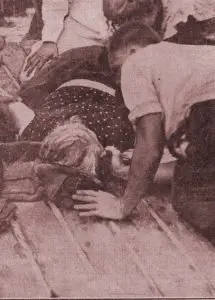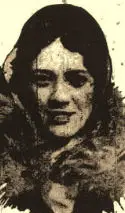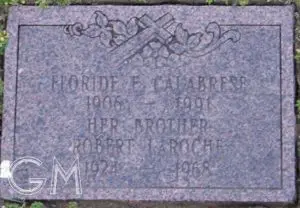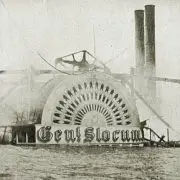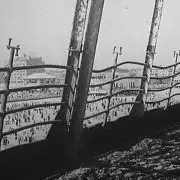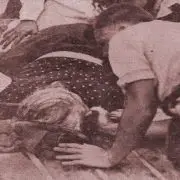Morro Castle, Mohawk and the end of the Ward Line : Part 2
All Overboard!
Augusta Pusrin, 27, of Queens (1911-2001) was unconscious and believed dead when she was pulled from the water on the morning of the fire. Blue faced and in deep shock she was placed with the bodies of Morro Castle victims aboard the City of Savannah, but as with the Lusitania’s Theodate Pope nearly 20 years before, someone saw a sign of life and she was revived. She later wrote:
There was a farewell dinner Saturday night. The dining saloon was hung with flags, balloons floated around, and the singing and chatter was interrupted only by the popping of champagne corks. Towards the end of dinner I noticed the doctor and some of the officers leave their tables, but neither I nor anyone else thought anything of it until an hour or so later in the lounge when the assistant cruise director gave us the news of Captain Wilmott’s death.
I went to bed about 1:30 AM Daylight Time, but I didn’t sleep. I had been seasick and didn’t sleep at all. After a long while I smelled smoke but there are so many peculiar odors on a boat that I thought nothing of it. Almost the next minute passengers started knocking on the door shouting “Fire! Fire! Get out! Fire!” I looked through my porthole and saw flames. I ran out of my cabin- I was in there alone at the time- and passengers were rushing for the stairs. One of them yelled to me to go and get a life preserver. I hadn’t the faintest idea of where they were. We never had a boat drill, despite reports that they were held every day. Someone told me to look under the bed. I did, and with the belt on I ran upstairs to C Deck.
Then I met Eleanor Friend (1907-1995) my chum, and some other girls. We weren’t frightened at all then, in fact we thought it was fun, because we were sure the lifeboats would take us off and we could see the lights from shore blinking. They looked so near it gave us courage.
Finally the flames reached the deck we were on. Someone yelled “all overboard” and people started jumping. We had to do it- the flames were suffocating.
I was really scared then. The belt kept me from sinking, and the water wasn’t cold. Eleanor was holding onto a rope from the boat, and I held on to her. Then we became detached and began drifting about. The waves were very high.
There Miss Pusrin’s memories all but ended. As so many of the passengers and crew did, she fell into a stupor and then lost consciousness after prolonged exposure. She had a fragmentary memory of briefly returning to consciousness in a lifeboat, but remembered nothing beyond that until she awoke aboard the City of Savannah.
27 Year old Pauline Kurland (1907-1988) of the Bronx returned to her family on the Jewish New Year, her survival giving them additional reason to celebrate. She had suffered a fractured arm, bronchitis and shock, and bore cuts and bruises across the front of her body. Like her traveling companion, Augusta Pusrin, she had leapt from the Morro Castle and drifted – mostly alone – for six hours before being picked up by a Coast Guard vessel. Friends and relatives gathered at her Morris Avenue apartment, where she was photographed embracing her mother and sister as she related the following account:
The passengers for the most part behaved very well, but as far as I could see the crew made no effort to help them. Captain Wilmott was very human and well liked. I had dinner with him, at his table, two hours before he died and he complained of no ailment then.
Miss Kurland had been at a stateroom gathering on D Deck, when smoke and passengers fleeing from the forward part of the ship were the first warning she and her friends were given. Thomas Cannon, one of those attending the small party procured a lifebelt and helped Miss Kurland put it on before they climbed the stairs to B Deck.
After Mr. Cannon got the lifebelts he gave me one and took one himself. We arrived on B Deck just as a man shot himself. The smoke and heat were terrible. I couldn’t see very well and when I was running to the rail I tripped over the body of a man lying on the deck.
At the rail, Mr. Cannon adjusted my life belt, then he jumped. I hesitated a moment before I jumped because I had lost all hope. I didn’t see how I could come out of the water alive, but I jumped.
In the water I grabbed a rope hanging from the stern of the ship and held on for several minutes but the sea was so rough I lost my grip. I started swimming. There were people all around me, floundering. A man grabbed me and held on for about a half hour but a wave cut him away. I couldn’t see whether or not he had on a lifebelt.
I can’t tell you much about what happened during the six hours when I was in the water. I didn’t lose consciousness, but I couldn’t see. The sea was tossing me around and the rain was beating down very hard. I was picked up after 9 o’clock by a Coast Guard cutter, and I passed out as soon as I was pulled into the boat. When I was revived I recognized two of the Morro Castle cruise directors in the boat.
One wonders about Miss Kurland’s claim to have witnessed a passenger shoot himself. The rest of her account is unexaggerated and ties in with those of other passengers. On the same day that Miss Kurland gave her account to a local reporter in the Bronx, 16 year old Louis Perrone, was claiming to a different reporter that he had heard shots and saw an officer standing over the body of a dead a crew member and that he, too, saw the body lying on the deck. While Miss Kurland’s account was not syndicated outside of the Bronx and went unnoticed, young Mr. Perrone’s drew a great deal of attention. Federal investigators wanted to question him, but he “collapsed” at home soon after meeting with the press , and his family took him to Princeton Hospital where he was shielded from the men from the United States Attorney’s office and from reporters as well. His aunt, Mrs. Howard C. Warren, issued a statement denying the story and, apparently, it ended there.
Miss Sidney Folkman of Riverside Drive, Manhattan recalled:
I was awakened about 5 o’clock by the smell of smoke. There wasn’t much time to get into clothes. The passengers were huddled on the rear of B Deck waiting for the fire to diminish, but soon the flames became higher and we realized how serious it was.
There was no chance to get a lifeboat, so I jumped. That took a lot of nerve, but I would have burned to death if I had stayed on the boat much longer. I had on a life preserver and floated around a while until a big piece of burned wood floated by.
At first there were three of us and later two more grabbed for it. One was an old woman who said she couldn’t hold on much longer. Finally she said “I can’t make it” and she slipped off into the water.
We seemed to be in the water all morning until a fishing boat came along and picked us up. I never felt better in my life as I was pulled into the boat.
Louise Taubert, 24, of Providence, Rhode Island, was returning from her Havana vacation with friends Florence Roberts, of Pawtucket, Floride “Flora” LaRoche, of Providence, and Ann Conway of Brooklyn. New York. The experiences of Miss Taubert and her companions demonstrate how, on the night of the fire, seconds separated life from death and a moment of indecision could easily prove fatal.Floride LaRoche, her head bandaged where it was cut by glass falling from a shattered promenade deck window, gave this account from her Freeborn Avenue home:
Louise Taubert The ship’s orchestra was playing “For All We Know We Shall Never Meet Again.” Louise and I were dancing, and now see what has happened.Florence and I were in the stateroom. We were sound asleep. Louise and I had been dancing. Then Louise went to play bridge – she later came in.
Suddenly we were awakened by a terrific pounding on the door. It was Ann calling for us to open the door and leave the stateroom. She said there was a fire on the ship. I stopped to put on a dress and some shoes and stockings and a coat. The other two girls who were dressed in pajamas went ahead of me. When I reached the promenade deck, Florence was there but we couldn’t find Louise. We screamed for her to join us, but we had lost her.A deck hand yelled “Follow me.” We followed him. Smoke was pouring in waves on both sides of us.
We made our way through the smoke to A Deck. We just got through the door and to the upper deck and it was filled with flames. Only Ann and Florence and I , and eleven members of the crew, were there. There was no one else on deck. We got into a lifeboat and they began to lower it. When we reached the surface of the sea the lifeboat was attached to the ship, somehow, and hot glass fell all over us. A piece struck me on the head, and Leroy Kelsey of Albany, New York, put his coat over my head. He also was bleeding very badly from a cut on the forehead.
The sea was terribly rough and it was pitch dark. We could not see a thing and there was no torch in the boat. When we finally got clear of the ship the seas were so high that they nearly swamped us. We couldn’t see anything, and I was never so thirsty in my life.When the boat was lowered we were right near the propeller.
It must have been three hours and a half before we finally reached shore. All the way it was raining very hard, but there was no lightning. Our boat was the first to reach the shore. There was no one there, but there were two people at the life saving station. We hollered to them, and they came out.
The three women were among the fewer than 25 Morro Castle passengers to escape by lifeboat. A report by Florence Roberts, not given in the first person corresponds to that of Floride LaRoche, but contains the additional information that the womens’ escape route took them through the galley, on D Deck, and that as she recalled, Miss Taubert became separated from the group on the stairs leading up to the boat deck. The ‘Galley’ reference is so far removed from the accounts of the other two women in Louise Taubert’s party that one wonders if perhaps itr was an improper transctription of “alley” used as a synonym for corridor. Ann Conway, in her account, which like that of Miss Roberts, was paraphrased by the newspapers rather than directly quoted, agreed with all of the details of Flora LaRoche’s account except for one. According to Miss Conway, Louise Taubert made it as far as the boat deck with the other women, but hung back for a second as the others-along with the unnamed deck hand who saved them-hurried into the smoke and flames that were pouring out of the windows along A Deck and up from the Promenade Deck. Miss Conway’s account agreed that Louise had been called to, but that it happened at the lifeboat station. When Louise Taubert’s body was recovered, it was unburned, so it can be assumed that she either jumped from the Boat Deck or somehow made her way back to the stern and left the ship from there.Floride LaRoche lived out the rest of her life in East Providence, Rhode Island. She worked for 25 years as a legal secretery, and died on January 17, 1991 at age 84 as Mrs. Floride Calabrese.
Louise Taubert was buried in the Corcoran family plot in St. Francis Cemetery, Pawtucket, Rhode Island. The monument marking the plot is impressive but Miss Taubert’s name is not inscribed upon it, nor does she have a footstone or plot marker. The others in the plot predate her by a good 40 years, and how she came to be buried there is unknown.

